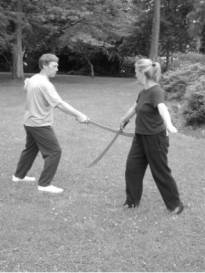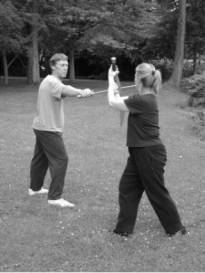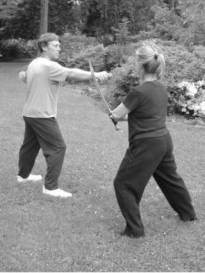 Gilman Studio On-Line Lessons
Gilman Studio On-Line Lessons
Yang Style Saber Application Form
Tai Chi Chuan
This Lesson Contains:
Applications
I am going to do things a bit different this time around. I will present all the applications first, then show the A side and then the B side as a solo form. This will be followed by showing the forms as they fit together. Finally I’ll teach the transitions between the sides.
So for now just study the applications and see how the Tai Chi principles are put into practice.
I will show the attack first and what would happen if the attack were not neutralized. I will follow with the response by the other side. This is followed with an attack by the other side, and the partner response, etc. I think it will be clear as you go through the applications.
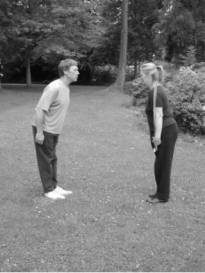
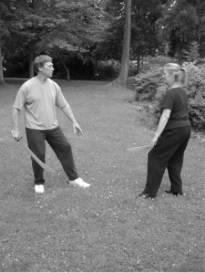 1) The two partners start the form by bowing.
1) The two partners start the form by bowing.
2) Both are in ready position.
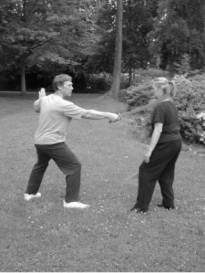
 1) A (Michael) steps in and attacks B’s (Stephanie) shoulder in a downward cut.
1) A (Michael) steps in and attacks B’s (Stephanie) shoulder in a downward cut.
2) B evades by stepping to the side and blocks with the side of her saber.
This is a very strong attack by A. It uses a large, swinging momentum to end with a very powerful step in and downward cut.
It is important for B to wait for the downward cut before she steps to the right side. In partner forms, it is easy to do your move without really waiting for the partner to finish his. If B sidesteps too early, A will just follow the step and cut as she moves. Bmust wait until A is firmly committed to the downward cut. It would be difficult for A to change direction in mid strike.
Notice how A’s arm is extended to the front. It makes a good target for B.
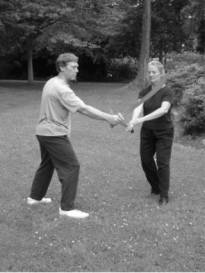
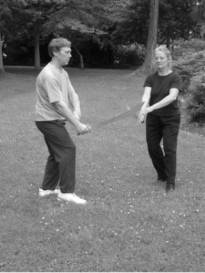 1) B, having gotten out of the way and blocked, now cuts to A’s wrist.
1) B, having gotten out of the way and blocked, now cuts to A’s wrist.
2) A withdraws his wrist.
B has stepped in and to the side of A. She cuts the wrist. As the cut comes down, Awithdraws his wrist. If he withdraws before B is committed to the cut, B will just cut some other part of A’s body if she can.
Notice how A has not only withdrawn his arm, but he has also pulled his body back into empty step to make foot changes easy.
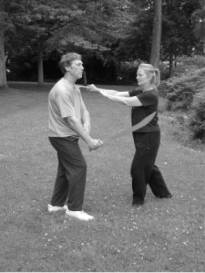
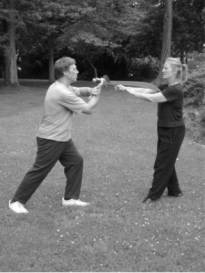 1) B steps in and slices A’s neck.
1) B steps in and slices A’s neck.
2) A steps back and blocks with the guard.
This illustrates the principle of changing levels of attack. B’s first attack was mid range – wrist. Now she attacks high with a neck slice. You can’t see it here, but if Breally had full intention with this cut, she would walk right on by A’s left side to carry through with this slice. This is called walking cut.
A takes a step back with his right foot and blocks the attempted cut with his saber guard. The guard is on the saber for good reason. At this point both people are in the same position. If either let down with awareness, the other could attack. Both have to stick if they are joined.
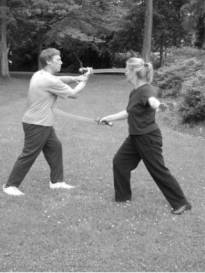
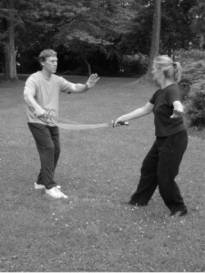 1) B steps to the left and pokes A’s belly.
1) B steps to the left and pokes A’s belly.
2) A steps back and neutralizes to the right.
Again we see the change of level. Since Ahas brought his saber up to block the neck cut, B steps in and to the left to poke the belly. This is a tricking step for B because she has to move around A’s saber. This works because B moves while A is bringing his saber up, not after it has attached to her saber. It is important to realize that much of what you see is faking one move and then doing another. When doing this form with a partner, you will probably hit sabers together when blocking and moving. In actual combat, the opponent’s are moving, faking, etc. to set up an opening.
A now empties his right side, steps back, joins with B’s saber, and leads it to the right into emptiness, closing her up.
2) B sidesteps and blocks A’s saber downward using her guard.
B is now open if she really attempted a lunge type poke. A steps in and pokes her belly. This works only if B was committed to her forward momentum. If not she has only to turn to the right to cut A’s neck.
B evades A’s poke by stepping to the left and at the same time, she joins and presses down ward on A’s blade with her guard. This illustrates the principle of moving in and around the opponent when possible.
2) B is stepping around and blocks as she does.
Since B has her saber down, A attacks high – to the neck. This is a fast, little flick. It is done with a twist of the wrist and elbow. It is not a strong movement.
B brings her saber up to block as she steps in and around. It is hard to see in this picture, but B is blocking with the strong portion of her blade – the part nearest the guard. Her preference would be to use the flat surface so as to not let her sharpened blade edge get damaged. Also notice that her left hand supports her right wrist to create a triangle of strength for this block.
2) A withdraws and sticks with his saber.
B has moved in and around and now cuts A’s wrist or forearm. This is a strong downward cut using both hands.
A pulls in his arm and turns his body to the right to face B. As he does this, the side of his saber joins with B’s. Both are now in equal positions.
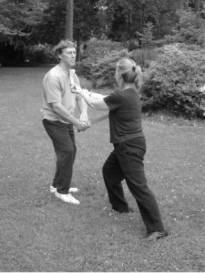
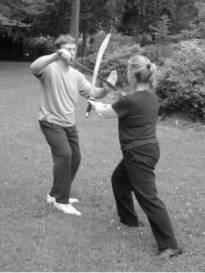 1) B steps in and slices A’s neck.
1) B steps in and slices A’s neck.
2) A blocks the attack.
Since A has brought his saber down to join,B now attacks high with a neck slice by stepping inside A’s blade. This has to be very fast since there is not much distance between A’s blade and B’s body. It is a bold move.
A quickly brings up his saber to block. Notice the diagonal position of the saber blade and the use of both hands to support the block.
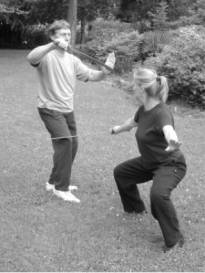
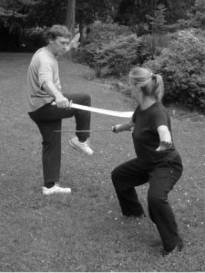 1) B ducks down and cuts A’s leg.
1) B ducks down and cuts A’s leg.
2) A gets his leg out of the way and cuts B’s wrist.
Again a change of level. Since A brought up his blade to block, B quickly ducks and slices A’s leg.
A swings his right leg to the left to get it out of the way, and cuts down on B’s wrist.
This is the end of the applications. I will teach the transition later. A will become Band B will become A. The transition is simple. When complete this form goes on as long as the partners want. There is also an ending that will be taught later.


